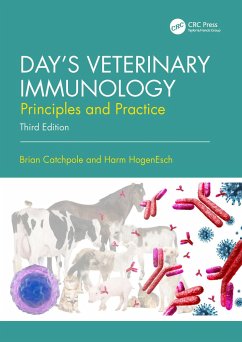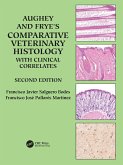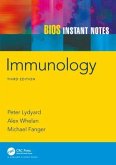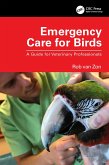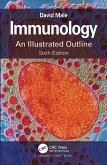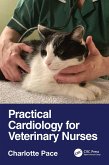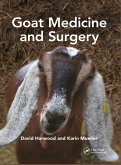Brian Catchpole (Royal Vet College), Harm HogenEsch (Purdue Univ.)
Day's Veterinary Immunology
Principles and Practice
Brian Catchpole (Royal Vet College), Harm HogenEsch (Purdue Univ.)
Day's Veterinary Immunology
Principles and Practice
- Broschiertes Buch
- Merkliste
- Auf die Merkliste
- Bewerten Bewerten
- Teilen
- Produkt teilen
- Produkterinnerung
- Produkterinnerung
Updated by Brian Catchpole and Harm HogenEsch with advances in knowledge since 2014, this third edition reflects the rapid development in the field internationally, while preserving the strengths of Day's original writing.
Andere Kunden interessierten sich auch für
![Aughey and Frye's Comparative Veterinary Histology with Clinical Correlates Aughey and Frye's Comparative Veterinary Histology with Clinical Correlates]() Francisco Javier Salguero Bodes (Public Health England)Aughey and Frye's Comparative Veterinary Histology with Clinical Correlates79,99 €
Francisco Javier Salguero Bodes (Public Health England)Aughey and Frye's Comparative Veterinary Histology with Clinical Correlates79,99 €![BIOS Instant Notes in Immunology BIOS Instant Notes in Immunology]() Peter LydyardBIOS Instant Notes in Immunology42,99 €
Peter LydyardBIOS Instant Notes in Immunology42,99 €![How to Raise a Puppy How to Raise a Puppy]() Stephanie RousseauHow to Raise a Puppy22,99 €
Stephanie RousseauHow to Raise a Puppy22,99 €![Emergency Care for Birds Emergency Care for Birds]() Rob van ZonEmergency Care for Birds77,99 €
Rob van ZonEmergency Care for Birds77,99 €![Immunology Immunology]() David Male (Health Department of Life & The Ope Chemical SciencesImmunology35,99 €
David Male (Health Department of Life & The Ope Chemical SciencesImmunology35,99 €![Practical Cardiology for Veterinary Nurses Practical Cardiology for Veterinary Nurses]() Charlotte Pace (Royal Veterinary College)Practical Cardiology for Veterinary Nurses55,99 €
Charlotte Pace (Royal Veterinary College)Practical Cardiology for Veterinary Nurses55,99 €![Goat Medicine and Surgery Goat Medicine and Surgery]() David Harwood (BVetMed, FRCVS Chairman, GVSGoat Medicine and Surgery88,99 €
David Harwood (BVetMed, FRCVS Chairman, GVSGoat Medicine and Surgery88,99 €-
-
-
Updated by Brian Catchpole and Harm HogenEsch with advances in knowledge since 2014, this third edition reflects the rapid development in the field internationally, while preserving the strengths of Day's original writing.
Hinweis: Dieser Artikel kann nur an eine deutsche Lieferadresse ausgeliefert werden.
Hinweis: Dieser Artikel kann nur an eine deutsche Lieferadresse ausgeliefert werden.
Produktdetails
- Produktdetails
- Verlag: Taylor & Francis Ltd
- 3 ed
- Seitenzahl: 404
- Erscheinungstermin: 31. Mai 2023
- Englisch
- Abmessung: 254mm x 182mm x 30mm
- Gewicht: 988g
- ISBN-13: 9781032317168
- ISBN-10: 1032317167
- Artikelnr.: 66698855
- Herstellerkennzeichnung
- Libri GmbH
- Europaallee 1
- 36244 Bad Hersfeld
- gpsr@libri.de
- Verlag: Taylor & Francis Ltd
- 3 ed
- Seitenzahl: 404
- Erscheinungstermin: 31. Mai 2023
- Englisch
- Abmessung: 254mm x 182mm x 30mm
- Gewicht: 988g
- ISBN-13: 9781032317168
- ISBN-10: 1032317167
- Artikelnr.: 66698855
- Herstellerkennzeichnung
- Libri GmbH
- Europaallee 1
- 36244 Bad Hersfeld
- gpsr@libri.de
Brian Catchpole is Professor of Companion Animal Immunology at the Royal Veterinary College, University of London. He graduated from the RVC in 1992 and after a period of time in veterinary clinical practice, returned to London to undertake a Wellcome Trust veterinary research training fellowship in the Infection & Immunity group at King's College London. After gaining his PhD, he returned to the RVC, initially as a postdoctoral research fellow and subsequently as a member of academic staff. Brian's research is focused on canine immunology, including studies into infectious disease (leptospirosis), immunosenescence, cancer immunotherapy and immune-mediated disease in dogs. Brian has been teaching immunology to veterinary undergraduates for the past 20 years. Harm HogenEsch is a Distinguished Professor of Immunopathology in the Department of Comparative Pathobiology of the Purdue University College of Veterinary Medicine. He received his DVM degree from the University of Utrecht, the Netherlands, and PhD in immunology from the University of Illinois at Urbana-Champaign. He is a Diplomate of the American College of Veterinary Pathologists. He worked for 3 years at the Institute for Aging and Vascular Research in Leiden, the Netherlands, before joining Purdue University. Harm's research interests include vaccine development and the immunopathology of allergic skin disease. He has published over 150 peer-reviewed articles and 22 book chapters. Harm teaches an immunology course for first year veterinary students and graduate students.
An overview of the immune system Important concepts and principles of
innate and adaptive immunity. Introduction. History of immunology. The
immune system: An overview. Principles of innate immunity. Principles of
adaptive immunity. Evolution of the immune system. Key points. Cells and
tissues of the immune system. Introduction. Haematopoesis and production of
white blood cells. Primary lymphoid tissues. Secondary lymphoid tissues.
The lymphatic system, lymphocyte recirculation and immune surveillance. Key
points. Innate immunity. Introduction. Defensive barriers.
Pattern-recognition receptors. Phagocytes and phagocytosis. Innate lymphoid
cells and natural killer cells. Lymphocytes with restricted diversity of
antigen receptors. The interferon response. The inflammatory response. The
acute phase response. Systemic inflammatory response syndrome. The
complement system. Key points. Lymphocyte development. Introduction.
Antigen recognition by lymphocytes. Development of B lymphocytes. T cell
development and maturation. Key points. The major histocompatibility
complex and antigen presentation. Introduction. The major
histocompatibility complex. MHC class I processing pathway. MHC class II
processing pathway. Antigen presentation by CD1 molecules to NKT cells.
Antigen presenting cells. Genetics and inheritance of the MHC. MHC
associations with immune function and disease. MHC and transplantation /
tissue graft rejection. Key points. Cytokines, chemokines and their
receptors. Introduction. Chemokines and chemokine receptors. Cytokines and
cytokine receptors. Key points. The biology of T lymphocytes.
Introduction. Chemokines and chemokine receptors. Cytokines and cytokine
receptors. Key points. Antibody structure and function. Introduction.
Antibody structure. Antibody binding to antigen. Biological properties of
antibody. Immunoglobulin classes. Key points. The biology of B lymphocytes.
Introduction. Antigen recognition by B cells. Activation of B lymphocytes.
The immunoglobulin class switch. Kinetics of the antibody response.
Monoclonal antibodies. Key points. Immunodiagnostics: Serology,
immunoassays and measurement of cell-mediated immunity. Introduction.
Serological tests and immunoassays. Immunophenotyping. Lymphocyte
stimulation assays. Tests of cytotoxic function. Tests of phagocytic cell
function. Key points. The immune response to infectious agents.
Introduction. The immune response to viral infection. The immune response
to bacterial infection. The immune response to helmith infection. The
immune response to protozoal infection. The immune response to fungal
infection. Key points. Immune evasion by pathogens. Introduction. Evading
the innate immune response. Evading the antibody-mediated adaptive immune
response. Evading the cell-mediated adaptive immune response.Specific viral
strategies for immune evasion. Key points. Vaccination. Introduction.
Passive immunization. Active immunization. Vaccine technologies. Vaccines
for non-infectious diseases. Vaccine adjuvants. Routes of administering
vaccines. Basic principles of vaccination. Vaccination failure. Adverse
consequences of vaccination. Key points. Immune system ontogeny and
neonatal immunology. Introduction. Immune system ontogeny. Passive transfer
of maternal immune protection. Neonatal vaccination. Failure of passive
transfer. Neonatal isoerythrolysis. Early life immune development. Key
points. Immunological tolerance and immune suppression. Introduction.
Tolerance and tolerance mechanisms. Central tolerance. Peripheral
tolerance. Mucosal tolerance. Fetomaternal and neonatal tolerance.
Antibody-mediated suppression. The neuroendocrine-immunological loop. Key
points. Immunodeficiency. Introduction. Primary immunodeficiency. Secondary
immunodeficiency. Key points. Hypersensitivity reactions. Introduction. The
Gell and Coombs classification of hypersensitivity. Type I
hypersensitivity. Type II hypersensitivity. Type III hypersensitivity. Type
IV hypersensitivity. Key points. Hypersensitivity disorders and allergic
disease. Introduction. Factors predisposing to allergic disease. Systemic
allergic reactions. Allergic skin disease. Respiratory disease.
Gastrointestinal disease. Diagnosis of allergic disease. Key points.
Autoimmunity and autoimmune disease. Introduction. The genetic basis for
autoimmunity. Intrinsic / host factors in susceptibility to autoimmune
disease. Extrinsic / environmental factors in susceptibility to
autoimmunity. Autoimmune diseases mediated by autoantibodies. Autoimmune
diseases mediated by autoreactive T cells. Diagnostic tests for autoimmune
disease. Key points. Cancer immunology and immune system neoplasia.
Introduction. Tumour antigens. The anti-tumour immune response.
Tumour-promoting immune activity. Immune evasion by tumours. Immunotherapy
to enhance the anti-tumour immune response. Tumours of the immune system.
Key points. Immunotherapy. Introduction. Immunosuppressive agents. Janus
kinase inhibitors. Intravenous immunoglobulin therapy. Allergen-specific
immunotherapy. Monoclonal antibody therapy. Cytokine therapy.
Immunostimulatory agents. Key points. Case studies in clinical immunology.
innate and adaptive immunity. Introduction. History of immunology. The
immune system: An overview. Principles of innate immunity. Principles of
adaptive immunity. Evolution of the immune system. Key points. Cells and
tissues of the immune system. Introduction. Haematopoesis and production of
white blood cells. Primary lymphoid tissues. Secondary lymphoid tissues.
The lymphatic system, lymphocyte recirculation and immune surveillance. Key
points. Innate immunity. Introduction. Defensive barriers.
Pattern-recognition receptors. Phagocytes and phagocytosis. Innate lymphoid
cells and natural killer cells. Lymphocytes with restricted diversity of
antigen receptors. The interferon response. The inflammatory response. The
acute phase response. Systemic inflammatory response syndrome. The
complement system. Key points. Lymphocyte development. Introduction.
Antigen recognition by lymphocytes. Development of B lymphocytes. T cell
development and maturation. Key points. The major histocompatibility
complex and antigen presentation. Introduction. The major
histocompatibility complex. MHC class I processing pathway. MHC class II
processing pathway. Antigen presentation by CD1 molecules to NKT cells.
Antigen presenting cells. Genetics and inheritance of the MHC. MHC
associations with immune function and disease. MHC and transplantation /
tissue graft rejection. Key points. Cytokines, chemokines and their
receptors. Introduction. Chemokines and chemokine receptors. Cytokines and
cytokine receptors. Key points. The biology of T lymphocytes.
Introduction. Chemokines and chemokine receptors. Cytokines and cytokine
receptors. Key points. Antibody structure and function. Introduction.
Antibody structure. Antibody binding to antigen. Biological properties of
antibody. Immunoglobulin classes. Key points. The biology of B lymphocytes.
Introduction. Antigen recognition by B cells. Activation of B lymphocytes.
The immunoglobulin class switch. Kinetics of the antibody response.
Monoclonal antibodies. Key points. Immunodiagnostics: Serology,
immunoassays and measurement of cell-mediated immunity. Introduction.
Serological tests and immunoassays. Immunophenotyping. Lymphocyte
stimulation assays. Tests of cytotoxic function. Tests of phagocytic cell
function. Key points. The immune response to infectious agents.
Introduction. The immune response to viral infection. The immune response
to bacterial infection. The immune response to helmith infection. The
immune response to protozoal infection. The immune response to fungal
infection. Key points. Immune evasion by pathogens. Introduction. Evading
the innate immune response. Evading the antibody-mediated adaptive immune
response. Evading the cell-mediated adaptive immune response.Specific viral
strategies for immune evasion. Key points. Vaccination. Introduction.
Passive immunization. Active immunization. Vaccine technologies. Vaccines
for non-infectious diseases. Vaccine adjuvants. Routes of administering
vaccines. Basic principles of vaccination. Vaccination failure. Adverse
consequences of vaccination. Key points. Immune system ontogeny and
neonatal immunology. Introduction. Immune system ontogeny. Passive transfer
of maternal immune protection. Neonatal vaccination. Failure of passive
transfer. Neonatal isoerythrolysis. Early life immune development. Key
points. Immunological tolerance and immune suppression. Introduction.
Tolerance and tolerance mechanisms. Central tolerance. Peripheral
tolerance. Mucosal tolerance. Fetomaternal and neonatal tolerance.
Antibody-mediated suppression. The neuroendocrine-immunological loop. Key
points. Immunodeficiency. Introduction. Primary immunodeficiency. Secondary
immunodeficiency. Key points. Hypersensitivity reactions. Introduction. The
Gell and Coombs classification of hypersensitivity. Type I
hypersensitivity. Type II hypersensitivity. Type III hypersensitivity. Type
IV hypersensitivity. Key points. Hypersensitivity disorders and allergic
disease. Introduction. Factors predisposing to allergic disease. Systemic
allergic reactions. Allergic skin disease. Respiratory disease.
Gastrointestinal disease. Diagnosis of allergic disease. Key points.
Autoimmunity and autoimmune disease. Introduction. The genetic basis for
autoimmunity. Intrinsic / host factors in susceptibility to autoimmune
disease. Extrinsic / environmental factors in susceptibility to
autoimmunity. Autoimmune diseases mediated by autoantibodies. Autoimmune
diseases mediated by autoreactive T cells. Diagnostic tests for autoimmune
disease. Key points. Cancer immunology and immune system neoplasia.
Introduction. Tumour antigens. The anti-tumour immune response.
Tumour-promoting immune activity. Immune evasion by tumours. Immunotherapy
to enhance the anti-tumour immune response. Tumours of the immune system.
Key points. Immunotherapy. Introduction. Immunosuppressive agents. Janus
kinase inhibitors. Intravenous immunoglobulin therapy. Allergen-specific
immunotherapy. Monoclonal antibody therapy. Cytokine therapy.
Immunostimulatory agents. Key points. Case studies in clinical immunology.
An overview of the immune system Important concepts and principles of
innate and adaptive immunity. Introduction. History of immunology. The
immune system: An overview. Principles of innate immunity. Principles of
adaptive immunity. Evolution of the immune system. Key points. Cells and
tissues of the immune system. Introduction. Haematopoesis and production of
white blood cells. Primary lymphoid tissues. Secondary lymphoid tissues.
The lymphatic system, lymphocyte recirculation and immune surveillance. Key
points. Innate immunity. Introduction. Defensive barriers.
Pattern-recognition receptors. Phagocytes and phagocytosis. Innate lymphoid
cells and natural killer cells. Lymphocytes with restricted diversity of
antigen receptors. The interferon response. The inflammatory response. The
acute phase response. Systemic inflammatory response syndrome. The
complement system. Key points. Lymphocyte development. Introduction.
Antigen recognition by lymphocytes. Development of B lymphocytes. T cell
development and maturation. Key points. The major histocompatibility
complex and antigen presentation. Introduction. The major
histocompatibility complex. MHC class I processing pathway. MHC class II
processing pathway. Antigen presentation by CD1 molecules to NKT cells.
Antigen presenting cells. Genetics and inheritance of the MHC. MHC
associations with immune function and disease. MHC and transplantation /
tissue graft rejection. Key points. Cytokines, chemokines and their
receptors. Introduction. Chemokines and chemokine receptors. Cytokines and
cytokine receptors. Key points. The biology of T lymphocytes.
Introduction. Chemokines and chemokine receptors. Cytokines and cytokine
receptors. Key points. Antibody structure and function. Introduction.
Antibody structure. Antibody binding to antigen. Biological properties of
antibody. Immunoglobulin classes. Key points. The biology of B lymphocytes.
Introduction. Antigen recognition by B cells. Activation of B lymphocytes.
The immunoglobulin class switch. Kinetics of the antibody response.
Monoclonal antibodies. Key points. Immunodiagnostics: Serology,
immunoassays and measurement of cell-mediated immunity. Introduction.
Serological tests and immunoassays. Immunophenotyping. Lymphocyte
stimulation assays. Tests of cytotoxic function. Tests of phagocytic cell
function. Key points. The immune response to infectious agents.
Introduction. The immune response to viral infection. The immune response
to bacterial infection. The immune response to helmith infection. The
immune response to protozoal infection. The immune response to fungal
infection. Key points. Immune evasion by pathogens. Introduction. Evading
the innate immune response. Evading the antibody-mediated adaptive immune
response. Evading the cell-mediated adaptive immune response.Specific viral
strategies for immune evasion. Key points. Vaccination. Introduction.
Passive immunization. Active immunization. Vaccine technologies. Vaccines
for non-infectious diseases. Vaccine adjuvants. Routes of administering
vaccines. Basic principles of vaccination. Vaccination failure. Adverse
consequences of vaccination. Key points. Immune system ontogeny and
neonatal immunology. Introduction. Immune system ontogeny. Passive transfer
of maternal immune protection. Neonatal vaccination. Failure of passive
transfer. Neonatal isoerythrolysis. Early life immune development. Key
points. Immunological tolerance and immune suppression. Introduction.
Tolerance and tolerance mechanisms. Central tolerance. Peripheral
tolerance. Mucosal tolerance. Fetomaternal and neonatal tolerance.
Antibody-mediated suppression. The neuroendocrine-immunological loop. Key
points. Immunodeficiency. Introduction. Primary immunodeficiency. Secondary
immunodeficiency. Key points. Hypersensitivity reactions. Introduction. The
Gell and Coombs classification of hypersensitivity. Type I
hypersensitivity. Type II hypersensitivity. Type III hypersensitivity. Type
IV hypersensitivity. Key points. Hypersensitivity disorders and allergic
disease. Introduction. Factors predisposing to allergic disease. Systemic
allergic reactions. Allergic skin disease. Respiratory disease.
Gastrointestinal disease. Diagnosis of allergic disease. Key points.
Autoimmunity and autoimmune disease. Introduction. The genetic basis for
autoimmunity. Intrinsic / host factors in susceptibility to autoimmune
disease. Extrinsic / environmental factors in susceptibility to
autoimmunity. Autoimmune diseases mediated by autoantibodies. Autoimmune
diseases mediated by autoreactive T cells. Diagnostic tests for autoimmune
disease. Key points. Cancer immunology and immune system neoplasia.
Introduction. Tumour antigens. The anti-tumour immune response.
Tumour-promoting immune activity. Immune evasion by tumours. Immunotherapy
to enhance the anti-tumour immune response. Tumours of the immune system.
Key points. Immunotherapy. Introduction. Immunosuppressive agents. Janus
kinase inhibitors. Intravenous immunoglobulin therapy. Allergen-specific
immunotherapy. Monoclonal antibody therapy. Cytokine therapy.
Immunostimulatory agents. Key points. Case studies in clinical immunology.
innate and adaptive immunity. Introduction. History of immunology. The
immune system: An overview. Principles of innate immunity. Principles of
adaptive immunity. Evolution of the immune system. Key points. Cells and
tissues of the immune system. Introduction. Haematopoesis and production of
white blood cells. Primary lymphoid tissues. Secondary lymphoid tissues.
The lymphatic system, lymphocyte recirculation and immune surveillance. Key
points. Innate immunity. Introduction. Defensive barriers.
Pattern-recognition receptors. Phagocytes and phagocytosis. Innate lymphoid
cells and natural killer cells. Lymphocytes with restricted diversity of
antigen receptors. The interferon response. The inflammatory response. The
acute phase response. Systemic inflammatory response syndrome. The
complement system. Key points. Lymphocyte development. Introduction.
Antigen recognition by lymphocytes. Development of B lymphocytes. T cell
development and maturation. Key points. The major histocompatibility
complex and antigen presentation. Introduction. The major
histocompatibility complex. MHC class I processing pathway. MHC class II
processing pathway. Antigen presentation by CD1 molecules to NKT cells.
Antigen presenting cells. Genetics and inheritance of the MHC. MHC
associations with immune function and disease. MHC and transplantation /
tissue graft rejection. Key points. Cytokines, chemokines and their
receptors. Introduction. Chemokines and chemokine receptors. Cytokines and
cytokine receptors. Key points. The biology of T lymphocytes.
Introduction. Chemokines and chemokine receptors. Cytokines and cytokine
receptors. Key points. Antibody structure and function. Introduction.
Antibody structure. Antibody binding to antigen. Biological properties of
antibody. Immunoglobulin classes. Key points. The biology of B lymphocytes.
Introduction. Antigen recognition by B cells. Activation of B lymphocytes.
The immunoglobulin class switch. Kinetics of the antibody response.
Monoclonal antibodies. Key points. Immunodiagnostics: Serology,
immunoassays and measurement of cell-mediated immunity. Introduction.
Serological tests and immunoassays. Immunophenotyping. Lymphocyte
stimulation assays. Tests of cytotoxic function. Tests of phagocytic cell
function. Key points. The immune response to infectious agents.
Introduction. The immune response to viral infection. The immune response
to bacterial infection. The immune response to helmith infection. The
immune response to protozoal infection. The immune response to fungal
infection. Key points. Immune evasion by pathogens. Introduction. Evading
the innate immune response. Evading the antibody-mediated adaptive immune
response. Evading the cell-mediated adaptive immune response.Specific viral
strategies for immune evasion. Key points. Vaccination. Introduction.
Passive immunization. Active immunization. Vaccine technologies. Vaccines
for non-infectious diseases. Vaccine adjuvants. Routes of administering
vaccines. Basic principles of vaccination. Vaccination failure. Adverse
consequences of vaccination. Key points. Immune system ontogeny and
neonatal immunology. Introduction. Immune system ontogeny. Passive transfer
of maternal immune protection. Neonatal vaccination. Failure of passive
transfer. Neonatal isoerythrolysis. Early life immune development. Key
points. Immunological tolerance and immune suppression. Introduction.
Tolerance and tolerance mechanisms. Central tolerance. Peripheral
tolerance. Mucosal tolerance. Fetomaternal and neonatal tolerance.
Antibody-mediated suppression. The neuroendocrine-immunological loop. Key
points. Immunodeficiency. Introduction. Primary immunodeficiency. Secondary
immunodeficiency. Key points. Hypersensitivity reactions. Introduction. The
Gell and Coombs classification of hypersensitivity. Type I
hypersensitivity. Type II hypersensitivity. Type III hypersensitivity. Type
IV hypersensitivity. Key points. Hypersensitivity disorders and allergic
disease. Introduction. Factors predisposing to allergic disease. Systemic
allergic reactions. Allergic skin disease. Respiratory disease.
Gastrointestinal disease. Diagnosis of allergic disease. Key points.
Autoimmunity and autoimmune disease. Introduction. The genetic basis for
autoimmunity. Intrinsic / host factors in susceptibility to autoimmune
disease. Extrinsic / environmental factors in susceptibility to
autoimmunity. Autoimmune diseases mediated by autoantibodies. Autoimmune
diseases mediated by autoreactive T cells. Diagnostic tests for autoimmune
disease. Key points. Cancer immunology and immune system neoplasia.
Introduction. Tumour antigens. The anti-tumour immune response.
Tumour-promoting immune activity. Immune evasion by tumours. Immunotherapy
to enhance the anti-tumour immune response. Tumours of the immune system.
Key points. Immunotherapy. Introduction. Immunosuppressive agents. Janus
kinase inhibitors. Intravenous immunoglobulin therapy. Allergen-specific
immunotherapy. Monoclonal antibody therapy. Cytokine therapy.
Immunostimulatory agents. Key points. Case studies in clinical immunology.

